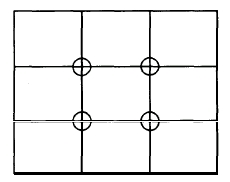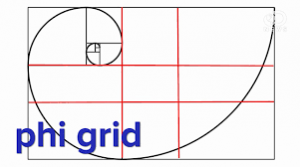Photo composition rules
- Rule of Thirds
- Diagonal rule
- Golden Section rule
Rule of Thirds

The Rule of Thirds is based on the fact that the human eye is naturally drawn to a point about two-thirds up a page. Crop your photo so that the main subjects are located around one of the intersection points rather than in the center of the image:
Your landscapes will be optimally pleasing to the eye if you apply the Rule of Thirds when you place your horizon line.
If the area of interest is land or water, the horizon line will usually be two-thirds up from the bottom. Alternately, if the sky is the area of emphasis, the horizon line may be one-third up from the bottom, leaving the sky to take up the top two-thirds of the picture:
As you’re taking an image you would have done this in your mind through your viewfinder or in the LCD display that you use to frame your shot.With this grid in mind the ‘rule of thirds’ now identifies four important parts of the image that you should consider placing points of interest in as you frame your image. Not only this – but it also gives you four ‘lines’ that are also useful positions for elements in your photo.
Before you snap the picture, imagine your picture area divided into thirds both horizontally and vertically. The intersections of these imaginary lines suggest four options for placing the center of interest for good composition. The option you select depends upon the subject and how you would like that subject to be presented.
Diagonal rule

One side of the picture is divided into two, and then each half is divided into three parts. The adjacent side is divided so that the lines connecting the resulting points form a diagonal frame. According to the Diagonal Rule, important elements of the picture should be placed along these diagonals:
Golden Section rule

t has been found that certain points in a picture’s composition automatically attract the viewer’s attention. Similarly, many natural or man-made objects and scenes with certain proportions (whether by chance or by design) automatically please us. Leonardo da Vinci investigated the principle that underlies our notions of beauty and harmony and called it the Golden Section. Long before Leonardo, however, Babylonian, Egyptian, and ancient Greek masters also applied the Golden Section proportion in architecture and art.
To get a clearer sense of these special “Golden” composition points, imagine a picture divided into nine unequal parts with four lines. Each line is drawn so that the width of the resulting small part of the image relates to that of the big part exactly as the width of the whole image relates to the width of the big part. Points where the lines intersect are the “golden” points of the picture:






























